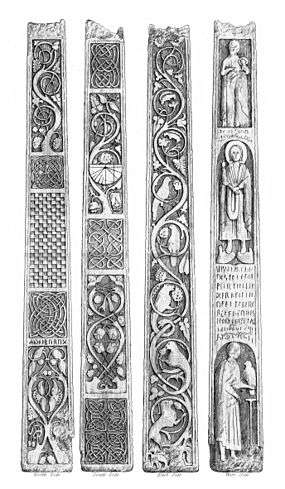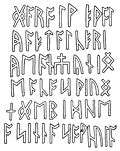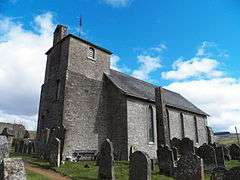Bewcastle Cross


The Bewcastle Cross is an Anglo-Saxon cross which is still in its original position within the churchyard of St Cuthbert's church at Bewcastle, in the English county of Cumbria. The cross, which probably dates from the 7th or early 8th century, features reliefs and inscriptions in the runic alphabet. The head of the cross is missing but the remains are 14.5 feet (4.4 metres) high, and almost square in section 22 x 21 1/4 inches (56 x 54 cm) at the base. The crosses of Bewcastle and Ruthwell have been described by the scholar Nikolaus Pevsner as "the greatest achievement of their date in the whole of Europe".[1]
Date
The cross is similar in many respects to the Ruthwell Cross, though the inscriptions are simpler, and seem to have a memorial function; together they are the largest and most elaborately decorated Anglo-Saxon crosses to have survived mostly intact, and they are generally discussed together.
The dating of both remains controversial, though Éamonn Ó Carragaáin, writing in 2007, says that "although there is lively discussion about the dates of these monuments, there is a growing consensus that both are to be dated to the first half of the eighth century: as it were, to the “Age of Bede” (who died in 735) or to the generation after his death"[2]
There have been suggestions that neither cross was originally a single piece of stone completed in one phase of work, and both have been proposed as the earlier.[3] The theory that the cross is probably the work of the team of masons and sculptors brought in by Benedict Biscop from the 670s to expand the monastery of Monkwearmouth-Jarrow Abbey, then one of the leading centres of culture in the Kingdom of Northumbria is still supported by the Bewcastle website;[4] this reflects the dating of scholars such as Meyer Schapiro.
Reliefs
Each of the four sides of the cross is intricately decorated with reliefs divided into panels depicting figures (west side only), animals, chequers, vine scrolls, interlace knots, as well as a sundial. The north, west, and south sides of the cross feature runic inscriptions. The largest relief on the side with figures is, as at Ruthwell, Christ treading on the beasts, below Saint John the Baptist. At the bottom, below a panel of runes, is a much-discussed figure of a falconer, who is possibly St. John the Evangelist with his eagle in an unusual depiction, possibly misunderstood from a Syrian model of John with an oil-lamp.[4]
The sundial on its surface, a canonical sundial, "is by far earliest English sundial to survive",[2] divided into the four 'tides' which governed the working day in medieval times.
Runic inscriptions



Scholars have contended that only the name Cyneburh is definitely decipherable on the cross. Cyneburh was a wife of Aldfrith but this was a common name at the time and might not refer to Aldfrith's wife. Alfredir was king of Northumbria, and died around 664.
The north side contains runes that are not easily decipherable, but may refer to Wulfere, among others, who was a son of Penda, and king of Mercia.
The inscription on the west side has been read as:
"thissig be(a)cn thun set(t)on hwa(e)tred waethgar alwfwolthu aft alcfrithu ean kuining eac oswiuing gebid heo sinna sawhula"
"This slender pillar Hwætred, Wæthgar, and Alwfwold set up in memory of Alcfrith, a king and son of Oswiu. Pray for their sins, their souls".
Referring to Egfrid, son of Oswy and brother of Alhfrith (also Alchfrith or Ealhfrith), who ascended to the throne in 670, the south side inscription has been read as:
"In the first year (of the reign) of Egfrid, king of this kingdom [Northumbria]".
Replica
A replica of the cross, including a guess at the missing part, is in the churchyard of the neo-Romanesque St Mary's Church at Wreay near Carlisle.[5] The Wreay cross differs in style and detail from the original and has been described as a "reinvention".[6]
Gallery
-

The falconer/St John figure
-

Bewcastle cross south perspective view
-

Bewcastle Cross - east and north faces
-

Bewcastle cross and church
-

Bewcastle church and cross from the west
-

North and west faces
-

Enhanced view of the north face
See also
- Easby Cross in the Victoria and Albert Museum, with Bewcastle and Ruthwell the best preserved Northumbrian cross
- Anglo-Saxon art
Notes
| Wikimedia Commons has media related to Bewcastle Cross. |
References
- Cook, Albert Stanburrough, ed. (1914). Some Accounts of the Bewcastle Cross Between the Years 1607 and 1861 H. Holt and Company.
- Cook, Albert Stanburrough (1912) The Date of the Ruthwell and Bewcastle Crosses. Yale University Press.
- Ó Carragaáin, Éamonn, Christian Inculturation in Eighth-Century Northumbria: The Bewcastle and Ruthwell Crosses, Colloquium Magazine, Vol 4, Autumn 2007, Yale Institute of Sacred Music, online text, with many photographs
- Page, Raymond I. (1960) "William Nicolson, F.R.S., and the Runes of the Bewcastle Cross", Notes and Records of the Royal Society of London, 14, pp. 184–90
- Pevsner, Nikolaus (1967) The buildings of England - Cumberland and Westmorland. Penguin Books.
- Schapiro, Meyer, Selected Papers, volume 3, Late Antique, Early Christian and Mediaeval Art, 1980, Chatto & Windus, London, ISBN 0-7011-2514-4 (includes The Religious Meaning of the Ruthwell Cross (1944), etc.)
- Thompson, David, Bewcastle information page
- Wilson, David M. (1984). Anglo-Saxon Art: From The Seventh Century To The Norman Conquest, Thames and Hudson (US edn. Overlook Press).
Coordinates: 55°03′49″N 2°40′55″W / 55.06361°N 2.68194°W
